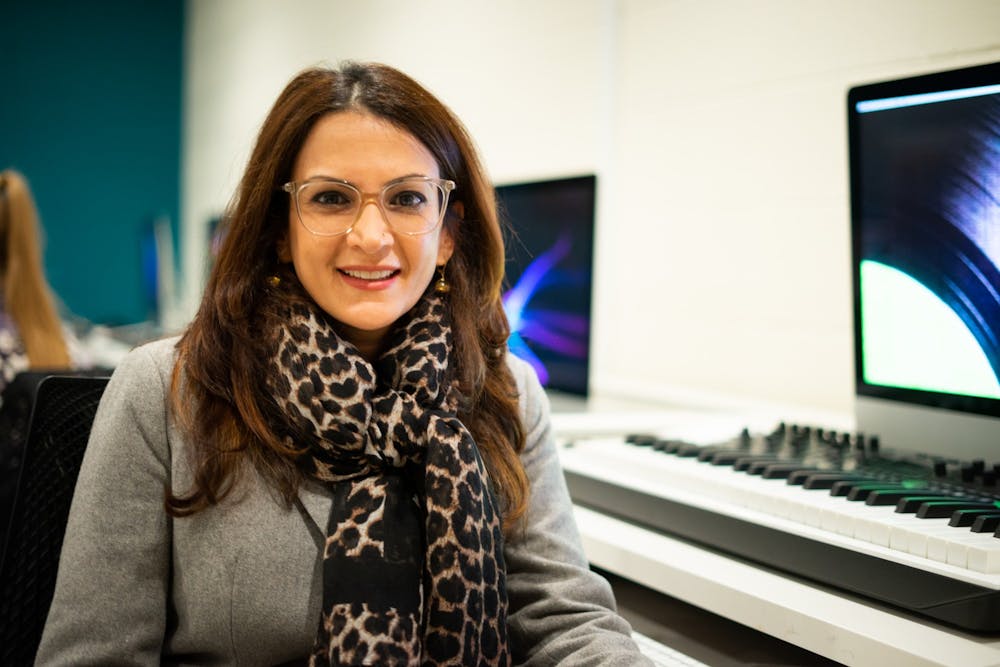With advances in virtual reality technology, a new field of filmmaking has emerged — one that allows artists to not just display their work to viewers but to bring viewers inside a world of their creation. The futuristic field of immersive media uses different — and often still developing — VR technologies to both capture and simulate physical spaces that can immerse users inside virtual models of real-life environments. At the University, one of the leading filmmakers in this field is Mona Kasra, associate professor of digital media design in the department of drama.
Kasra’s works aim to explore the possibilities of immersive media, pushing its boundaries where possible. Whether she is filming glacial landscapes in Alaska, recording indigenous ceremonies in northern Australia, or merely capturing glimpses of daily life in Charlottesville, Kasra uses this experimental approach.
This semester, she has split her time between teaching digital media classes for the New College Curriculum, leading a Mead Scholars group focused on exploring the intersection of VR and storytelling, working on a short immersive film shown during the Virginia Film Festival and collaborating with students and faculty across different departments on several interdisciplinary projects. When asked to examine her work, Kasra said that she hopes to examine what these new media mean “socially, culturally, artistically and politically, as they get more embedded in our into our culture.”
To create many of these works, she uses a technique called 360 degree filmmaking. Unlike traditional screen-based media that can only display one perspective, this technique uses specialized camera equipment — which can vary between eight GoPro cameras stacked on top of each other to a six-lensed camera that Kasra describes as three sets of eyes — to capture images and sounds from all angles.
Once she has finished filming, Kasra and her team use different computer programs to create 360 degree virtual renderings of the original space, stitching together the audio and visual stimuli, so that viewers can interact with complete physical environments.
“When you're in this space, this image just wraps around you,” Kasra said. “You kind of feel like you're in there, and things are far or near to a degree. So, it's a much more real experience.”
Additionally, with immersive VR, the user is given more agency than traditional screen-based media. When users are in this virtual space, they get to choose where to direct their attention based on their own interests — meaning that they become the cinematographers of the work.
Andrew Carluccio, fourth-year College student and one of Kasra’s programming collaborators for her project in Australia, notes that while this is exciting, it presents a challenge from the perspective of a programmer.
“You're trying to design these nonlinear experiences and make sure that you have a great experience for every possible path that the user might want to take,” Carluccio said.
When this designing is done properly however, the resulting work allows users to explore spaces that they may not be able to experience on their own. That is a driving force behind Kasra’s projects in Alaska and Australia. Working with Matthew Burtner, professor of music and Alaskan-born sound artist, Kasra is developing a virtual experience that will allow her audience to interact with the transient glacial landscapes of Alaska. She collected audio and visual materials in the summer of 2019, which she will now develop into a fully immersive experience.
“The idea is to create this immersive space that has the poetic representation of stillness, beauty, change,” Kasra said. “It would be very experimental.”
Similarly, her work in Australia will also use motion capture technology to recreate spaces that are inaccessible to most people. Alongside Luke Dahl, assistant professor of electrical and computer engineering, Kasra has received a hybrid scholarship in June from the Institute for Advanced Technology in the Humanities to explore how these new media can be used to document, preserve and share cultural practices of indigenous communities. For this project, she will create 360 degree audio-visual recordings of Australian Aboriginal dance ceremonies, that will then be transformed into virtual environments that users anywhere can experience.
Carluccio, who will serve as the programmer for this project, said that the hope is for these kinds of virtual experiences to help build relationships between the user and other underrepresented perspectives. In such, this technology holds the possibility of forming bridges between people whose lives might otherwise not cross and sharing stories in a much more lifelike manner.







